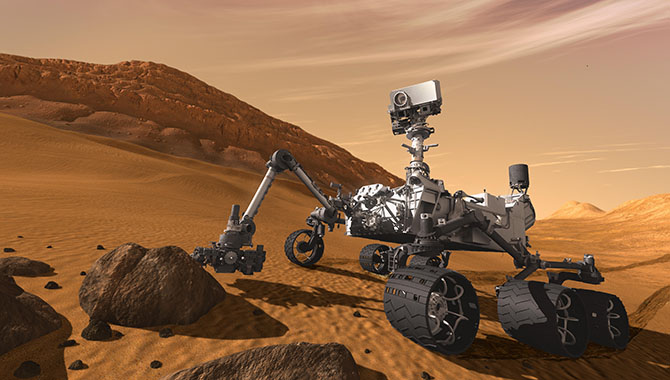
The Curiosity rover was subjected to stringent sterilization procedures.
Image Credit: NASA
The NASA/Caltech Jet Propulsion Laboratory (JPL) is the lead NASA field center for the robotic exploration of the solar system. JPL recognizes the importance of capturing and retaining key knowledge related to the design and operation of spacecraft systems. Once an aircraft manufacturer loses a key system engineer, there are likely competitors from whom to obtain a replacement. But once JPL fails to adequately document knowledge on an esoteric topic such as Mars Entry, Descent, and Landing (EDL), there exists no similar organization that can supply such expertise.
“VIDEO IS THE NEW DOCUMENT”
Due perhaps to the pervasiveness of e-mail and presentation tools, NASA engineers today may be less disciplined in preparing formal technical memoranda than their predecessors 20 years ago.1 Five years after a decision is made, when the mission launch date arrives, no one may be able to answer the question, “So why did we set the value of that software alarm to ‘Off’ for launch?” Video recording offers significant advantages over documents in capturing technical decision-making and training: It requires no scribe, and it more accurately captures the nuances and emotional content of interpersonal communications. And with high-definition cameras available in cellphones, video recording today requires little specialized equipment or expertise. Arranging for a professional JPL videographer to film a one-hour meeting in a conference room may cost $1,000, in contrast to quite adequate video and audio quality from a cellphone propped up on the conference table. Once recorded and archived, however, video documentation is not very accessible. It is usually impractical to find a key piece of information from within hundreds or thousands of hours of video content.
JPL TUBE
JPL teamed with Microsoft Research and NASA IT Labs to develop JPL Tube, an online tool with a format and operability similar to YouTube®.Image Credit: NASA
Hence, JPL teamed with Microsoft Research and NASA IT Labs to develop JPL Tube, an online tool with a format and operability similar to YouTube®. Any U.S.–based person within the JPL firewall can upload or view videos. As a video is uploaded, JPL Tube automatically generates a scrolling transcript that keeps pace with the frames in the film. This transcript aids in user comprehension of the technical material. Also, this produces significant labor savings in achieving compliance with the Rehabilitation Act of 1973, which requires Federal agencies to make their electronic and information technology accessible to people with disabilities. But more significant, associating a textual transcript with a video makes the video full-text searchable. A search of the site by a user produces one or more video snippets that contain the search string. Clicking on a selected snippet keys the user to a specific video, and to a specific point within the video where the topic is discussed.
For example, NASA policy and good practice requires JPL to sterilize spacecraft surfaces to prevent contamination of alien environments by Earth organisms. Hence, a JPL Tube user might ask, “How effective are alcohol wipes in sterilizing spacecraft?” Robert Koukol taught an eight-hour seminar at JPL in 2013 titled “Planetary Protection Training for Cognizant Engineers, Principal Investigators, and Scientists.” The seminar was recorded and posted to JPL Tube.
If a user were to enter the search string “alcohol wipes” into the JPL Tube search window, the search results would include two video snippets. One of the two is a snippet from approximately two hours into Mr. Koukol’s presentation.
The transcribed video snippet includes the following remarks by Mr. Koukol:
“Alcohol wipes! Everybody says, ‘Oh, so the alcohol kills the organism?’ Ah, if you want to save bacterial endospores, if you want to save the spores, a really good way to do it is to store them in alcohol. So it really doesn’t kill off the spores at all. Now, it will kill off vegetative cells—the kind of stuff we have on our skin that we are worried about. Or if you know one of the big things now is that everyone has anti-microbial soaps and anti-microbial sprays, and everything else. You go to the grocery store and they have this little thing and you pull the wipe down and wipe the handle on the shopping cart…”
MICROSOFT’S MAVIS
For the transcription, JPL Tube employs the Microsoft Audio Video Indexing Service (MAVIS®), which uses Deep Neural Net (DNN) technology and Probabilistic Word-Lattice Indexing to convert digital audio into text. Artificial neural networks employ statistical algorithms that mimic biological nervous systems in the way that they learn by recognizing patterns within a large amount of input data. In contrast, more conventional speech recognition technology requires multiple passes over an audio file, providing incremental improvements in the transcription. Microsoft claims that the DNN approach offers greater speed and accuracy.
JPL is the first subscriber to employ MAVIS in a complete system that allows untrained users to add videos to the collection. Uploading a video and adding related metadata takes a few minutes. MAVIS is a product of Microsoft Research; under the current MAVIS license, JPL is charged about $10 per hour of video. JPL Tube came online in 2012, and JPL personnel have presently uploaded over 1,200 videos. Over the quarter ending September 30, 2015, an average of 324 videos per day were viewed by JPL users of the system. Because JPL Tube access is limited to U.S. persons at JPL, JPL does not require International Traffic in Arms Regulations (ITAR) clearance before videos can be posted. This has eliminated a potentially time-consuming and expensive constraint to video capture.
JPL recently incorporated a number of JPL Tube enhancements, including:
- An increase in the maximum permitted upload size from 4GB to 8GB. Previously, a multi-hour video had to be uploaded as discrete segments.
- A capability for the contributor to return to the uploaded video and edit the transcript.
- A multi-threading capability for JPL Tube, in which multiple videos can be uploaded and processed simultaneously.
NASA TUBE
NASA asked JPL to develop a NASA Tube with similar features to the JPL product. A pilot version of NASA Tube went live in September 2015 with 141 videos pre-loaded. Due to some NASA security compliance issues, the pilot version does not at this time allow NASA personnel to upload additional videos. But they can review the other tool capabilities at nasatubedev.nasa.gov (NASA Only).
JPL and NASA missions are high-risk endeavors because the spacecraft are typically one-of-a-kind, high-unit-value engineering designs intended for operation in an extremely hostile environment. Lost knowledge presents not only the additional cost of restoring it but also a higher risk because the legacy knowledge had been verified through system test and spaceflight. JPL Tube has the capability to transform the retention of technical know-how by capturing key knowledge at a very reasonable cost without the need for a human scribe. The utility and benefits from JPL Tube processing, storage, and search have been demonstrated for more than two years, and JPL is eager to extend this capability Agency-wide.
David Oberhettinger is the Chief Knowledge Officer at NASA Jet Propulsion Laboratory.
1 G. Robinson, NASA Office of the Chief Engineer, Memo No. 6208 (“Documentation”), September 16, 2005.









